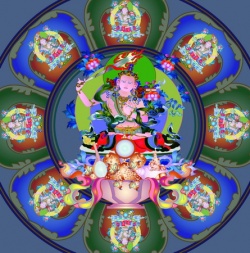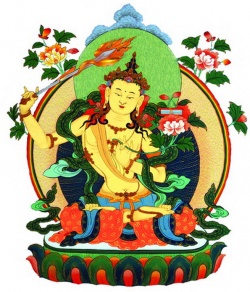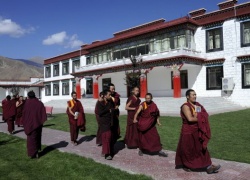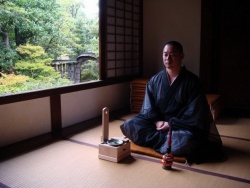On Chöd, bodies of illusion, and transmission of the blessings of lineage…
by Repa Dorje Odzer
A reader recently reached out on facebook and asked me to write a blog post touching on how lineage inspires us and how transmission works in modern day terms. Needless to say, I was heartened by her request as I found it flattering, and because I have been playing around with this topic as it pertains to teaching Ngöndro at New York Tsurphu Goshir Dharma Center. So, as an offering to this friend I write this post, warts and all, please feel free to correct it where I stray.
As Monday was Chotrul Düchen I went to Greenwood Cemetery to practice Chöd and Marpa guru yoga. It had been a while since I had practiced there and I have been trying to remain aware of all of the local spirits, gods, and other beings whenever we do Chöd at the center as well as when we do our daily offerings to the protectors as of late, why not add cemetery beings as well, no? Lest we forget, vajrayana brings with it a wide spectrum of beings, beings that we often risk denying existence by having an overly symbolic read of this particular vehicle. I tend to feel that the more one does Chöd, the more one can sense some of what may linger in places like cemeteries and other similar places. It is easy to say that our cemeteries are nothing the the charnel grounds of yesteryear- the terrifying haunted ones frequented by dakinis, tigers, jackals and other scavenging animals.
At Greenwood you won’t find freshly dead bodies rotting in a forest- visceral reminders of impermanence that grab- but when you take the time to really feel and take-in the monuments left behind to memorialize the pain of death, the sad realization that “this too did pass”, somehow the quiet solitude of the cemetery becomes quickly filled with spectres of those who passed in all manners of ways. Whether poisoned, or burned to death, drowned, or left alone, most ways of having met death are preserved there. Indeed, it is probably safe to say that very few of those whose remains are slowly composting were okay with the process of dying. There is something so amazing about getting out and doing Chöd and other practices in the world- its a poignant way to bring the world into one’s practice.
Chöd has long been practiced “in the field”, so to speak, that is, in cemeteries, charnel grounds, places of fear and similar such locations. A reader once pointed out to me how civil war battlefields are excellent places for such practice; indeed they are, as are Superfund sites and industrial wastelands (the modern day charnel ground?). There are many. Taking one’s practice outside and into the world can be a powerful way of emulating the examples of those notable lineage holders that we direct our prayers towards. It may well be that the places in the sadhana where we take refuge in all of the siddhas in the Chöd lineage, the father lineage of method headed by Padampa Sangye, and the mother lineage of wisdom headed by Vajrayogini herself, when we are doing this practice in a cemetery, or a place that instills fear, a place of desolation, we create the conditions to reflect, the activities of Machik Labdron and all of the many facets of the lineage of Chöd that she inspired.
In this way we are manifesting a matrix of blessings that constitute a transmission of blessings that can be more real than we think. This is very real and significant inner connection with the Chöd lineage, is something to hold dear and blend with one’s being. These moments of sustaining connection when we feel confidently grounded, when it feels as if we are carrying the lineage with us as we walk to the grocery store, as we awaken in the morning, as we practice in formal sessions and as we go about our lives in post-meditation are incredibly profound.
Seated next to the cold marble monument of the Hope family, amid the late winter/early spring afternoon light, as the sun peeked through the clouds revealing patches of rich blue, I invited Greenwood’s slumbering guests. I offered the mudras of body speech and mind; all that appears as form, all that is heard as sound, and all that is thought or conceived of by the mind to the supreme assembly of the Chöd lineage. These offerings, the entire ground of my experience of that particular moment became an offering to Machik Labdron, Padampa Sangye and his retinue, Vajrayogini and her retinue, Lord Buddha, Prajnaparamita and an array of Chödpas, as well as the eight classes of gods under oath, rakshas and rakshasis, mamos, demons of illness and karmic creditors.
That moment, spent in a vast cemetery in Brooklyn, surrounded by over five hundred thousand graves, a wonderful practice site that is also the location of the Battle of Long Island, the first and largest battle in the American Revolution, became a moment of connection, a moment where the possibility of intimacy with a particular practice arose and provided great meaning. Moments like these, when we can dissolve the notion of Self, fully adorned with our foibles and limitations, our fears and anxieties, ornamented by our feelings of inferiority and clumsiness, when this can recede into the dawn of resting within the experience of the simultaneity of the field of refuge and our experience of mind, we create the occasion of inner empowerment, of blessing, of relationship which connects us beyond time and space to our lineage. This is what keeps everything fresh and allows us to appreciate the illusion-like mirage of who we think we are.
I am always relieved (and grateful) whenever this experience occurs (sadly, it is not a very frequent occurrence) as these moments serve to remind me of just how much intention is part of the essential fuel of meaningful dharma practice. We are often taught the importance of developing bodhicitta- the mind of enlightenment. This is crucial. It is the way we frame and contextualize our practice; reflecting upon bodhicitta acts in a twofold manner: giving our practice meaning as well as bolstering it through the merit created by the generation of compassionate resolve (relative bodhicitta) and the wisdom of emptiness (ultimate bodhicitta).
While this is really important- it seems like an additional intention is vital as well, a point that was instilled in me by my first teacher, the late Ani Dechen Zangmo. This is the intention that our practice brings fruit in a natural unimpeded way, that we open ourselves up to experiencing the possibility of fruition. If for example, we begin our practice sessions convinced that we are complete failures and that practice will only benefit us slowly over incalculable aeons, then there is a strong likelihood that this is how our experiences may arise. It doesn’t mean that just because we think we will get enlightened in one meditation session that we will, rather, her advice was to keep alive the possibility that our practice will bring fruit- because after all, one day it will. Whether it be Ngöndro, Chöd, Calm Abiding, or any other form of practice- when we disconnect ourselves from the inevitability of our recognition of our inherent Buddha nature we throw a rather large self-created stumbling block in our way.
I am reminded of an Irish woman who I befriended fifteen years ago in Bodh Gaya. We came to be friends over many shared breakfasts with a large group of western practitioners who stayed at the Burmese Vihar. At the time she was following a Gelukpa teacher- and for some reason that I fail to remember, was encountering doubt about her practice. I had suggested that she meet the late Kyabje Bokar Rinpoche, a very dear teacher, who was leading the Kagyu Monlam, and helped to arrange a meeting. It proved to be meaningful to her as ten months later I ran into her at Bokar Rinpoche’s annual Mahamudra Seminar. At one point after lunch she and I met for tea and I asked what she thought of the seminar- she started to cry and then smiled and told me how amazed she was by the fact that Bokar Rinpoche suggested that our practice could bring the fruit of realization in this life-time. The very notion that realization wasn’t necessarily something that was to be experienced at some point in the distant future was so counter of the view that she had cultivated- she was now tasting the possibility, she was joyful, light, buoyant; she seemed to have had a profound realization that changed her. It was really amazing- recalling that afternoon conversation still brings great joy to me and leaves me feeling happy.
That the experience of deep realization need not be something that eludes us because of a particular conception of time, or because we think that we are unworthy, or unable, broken, far away from our teacher, or tiny is something that can run counter to the way we see the world around us and our experience of it. This is not to diminish these feelings. I realize just how easy it can be to feel distant, incapable and unworthy. Yet I have come to learn from my own experience that during those moments when I can naturally offer all appearance, all sound, all mental formulations; when I can just rest in the experience of mind; when everything seems to settle into ease; then I am reminded of the illusory nature of Self, and that it is not real. These moments of receptivity are powerful and they break the habit of feeling that we are deluded beings, they are moments of empowerment, and personal moments of inner transmission.
Along these lines, we find in the guru yogas of Milarepa, Gampopa and Marpa prayers that help us keep the possibility of the experience of direct awakening ever present:
Grant your blessings so that all obscurations of karma, klesha, knowledge and habitual tendencies may be purified at this very moment.
Grant your blessings so that they may be purified on this very seat.
Grant your blessings so that they may be purified during this very session.
Grant your blessings so that our very beings may be purified.
Grant your blessings so that our very beings may be liberated.
Grant your blessings so that they may be liberated at this very moment.
Grant your blessings so that may be liberated on this very seat.
Grant your blessings so that they may be liberated during this very session.
This very moment! This very seat! This very session! What say you? Does this fall within our frame of reference? I can only speak for myself, but I sincerely hope it does.
In a way this view is worth exploring when it comes to receiving empowerments, or the transmission of a particular dharma from a qualified lineage holder. Just as we explored above our relative receptivity towards actually being empowered within our practice, and what those experiences are like, it is worth looking at how we take empowerments, and when we do, what it is that we are receiving.
Before I go any further I would like to underscore my lack of qualifications for actually having any real worthy insights on this topic and to share the title of an excellent book that touches on a variety of aspects around empowerment, that is Tsele Natsok Rangdröl’s Empowerment and the Path of Liberation. I cannot recommend this book enough, and must warn that in comparison to the words of Tsele Natsok Rangdröl, my words are not much more than the dance of a puppet that is being used by a blind, deaf and mute crazed puppeteer. Nevertheless, I feel that the view instilled by Ani Zangmo and the late Kyabje Bokar Rinpoche are worth examining especially in regard to what is possible when we attend and receive empowerments.
It is generally said that in the past, especially when great masters were conferring empowerments, that the power of the blessings of the practices were so strong that there was the distinct possibility that the act of conferring empowerment had the effect of completely ripening the recipient thereby creating the circumstances for immediate enlightenment. These days this is very rare indeed. It is also worth noting that in the good old days of 5th through 12th century India the nature of conferring empowerments may have been somewhat different than what we have come to experience these days. The stories found in the Seven Instruction Lineages by Jonang Taranatha, capture some of the atmosphere of what things may have been like.
Generally speaking there are four empowerments: vase empowerment, secret empowerment, knowledge/wisdom empowerment, and the precious word empowerment. Each of these empowerments help to ripen us in differing ways so that we may actually achieve the experience of the particular deity for whom we are being empowered. The vase empowerment purifies all negative karma created by the body, blesses the vajra-body, empowers us to enter into creation stage practices, and allows one to achieve the nirmanakaya stage. The secret empowerment purifies all negative karma created through speech, empowers us to recite the mantra, allows us the possibility of achieving illusory-body as well as the sambhogakaya stage. The knowledge/wisdom empowerment purifies all negative karma created by mind, blesses the vajra mind, plants the seeds for the experience of fierce blazing, lays the ground for achieving the dharmakaya stage. The precious word empowerment purifies all negativities created by body, speech, mind and all obscurations, in the Nyingma tradition it plants the seeds for treckchö, and in the Kagyu lineage it plants the seeds for the experience of the state of Vajradhara, the experience of bliss-emptiness, supreme mahamudra, the svabhavikaya.
Again, as I am by no means an expert, I heartily refer those interested to explore Tsele Natsok Rangdröl’s work as well at Book Six/Part Four of Jamgon Kongtrul Lodro Thaye’s masterpiece, The Treasury of Knowledge. Chapter 12 deals with Initiation- there is a wealth of knowledge to be found in this chapter. Each lineage has differences in the structure of empowerments, and one also finds diversity in the way that the empowerments are broken down or elaborated upon, Hevajra is different than Chakrasamvara, and Kalachakra is different still. Nevertheless, despite the wide range, there are tonal similarities that are clear and distinct, as it the central importance of empowerment and transmission in vajrayana.
Of the function and purificatory effects of empowerment, Kongtrul says:
Initiations purify the obscurations of body, speech, and mind, and the three equally,
Establish competencies for the four indestructible states, ripen one as a fit trainee
Of the generations stage, self-blessing, and example and actual pristine awareness,
And bring about the attainment of the rank of vajra master.
Kongtrul essentially says that empowerments plant the seeds for all of the subsequent practice related to the empowerment. From the permission to visualize oneself as the deity and begining to tread the path of the generation stage all the way through completion stage practices, through to the fruition activities of the vajra master. This view is held as central today amongst the vajrayana lineages today as it was during Kongtrul’s time in the 19th century.
When large transmission cycles are offered, as in the case of the Kagyu Ngak Dzöd which was recently given by the precious master His Eminence Goshir Gyaltsab Rinpoche at his monastic seat, Densa Palchen Chosling Monastery, or when the Rinchen Terdzöd or Dam Ngak Dzöd are given these cycles of empowerments are often given to fulfill a few functions. These large cycles serve to offer to the next generation of young masters the transmissions that they will receive, maintain and propagate, thereby guaranteeing that the dharma continues through time. Some of these cycles have specific groupings so that disciples can receive a certain themed set of empowerments. Lastly these collections act as storehouses where some of the rarer empowerments are protected such as Buddhakapala and Chatuhpita.
There are many ways that people receive empowerments, in some cases we take them as we would a blessing, in other cases it might be to create a connection with a particular cycle of practice, or with a particular master of the past. Sometimes we specifically take them as we know that we will be taking these practices on in the future. From there we move on to obtain the reading transmission and instructions on perform the desired the practices.
Whichever the case may be, it might be worth considering that a great deal rests upon our intention as we receive these transmissions so that their intangible benefits are also transmitted: the blessings, the connection with the vajra master and with our fellow participants who we become karmically linked with, as well as all of the ripening effects of all of the articles of empowerment, vase, crown, vajra and so on. We should certainly engender the mind of awakening throughout the process, and we should keep in our mind that in receiving empowerment we also forge a connection with an entire transmission lineage throughout time. We become part of the lineage and it us: where is the difference between the lineage and our mind?
Can we allow the possibility of cultivating the ground which contains the seeds of the four empowerments? We never really know just how close those sprouts may be to pushing up the rich fertile soil of our being and fully manifesting.
In this way, in our own deeply personal way, we receive the lineage. It is a profound time of vast meaning. It may be that if we take empowerments with a focused resolve to actually receive the lineage, the connection, the blessings, the ripening and the not very easily communicable essential experience of the nature of mind, that what is conferred is the true lineage. Whether this is actually true or not is difficult to know (or prove), but it does stand to reason that even though the actual conferral of an empowerment contains many benefits that enrich us, there is a lot that we too can bring to the experience. Receptivity is one thing; if we can allow ourselves to stretch this sense receptivity through time and space then the transmission that we receive can be as complete as can be. In a moment we can recieve the transmission of a complete expression of enlightenment.
Whether we are mixing the body, speech and mind of Machik Labdron with ours, thereby receiving direct empowerment from her, or from Lord Marpa during a session of guru yoga on the anniversary of his parinirvana, or from our very own vajra master in flesh-and-blood, the degree to what we receive and how completely it blends with our being is up to us. May we all receive and hold the transmission of the wondrous buddha-dharma and may we manifest it completely and perfectly! May all of phenomena be a precious charnel ground where we can reach beyond the limitations of this illusory self and experience the expansive ground of awareness! As winter turns to spring, may the seeds of empowerment begin to sprout everywhere allowing for the complete expression of wisdom-mind like a rising sun!
Gewo!




